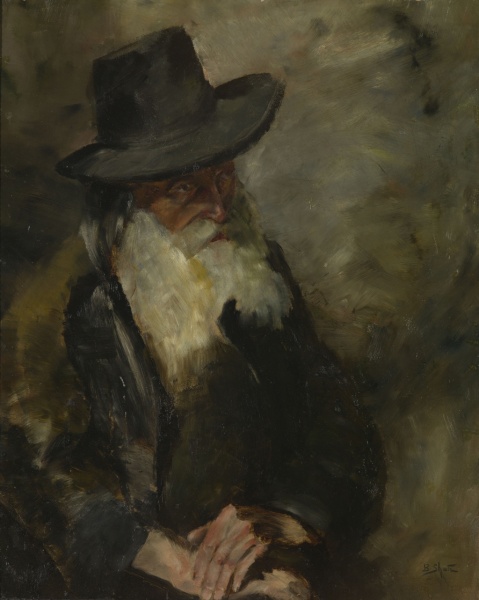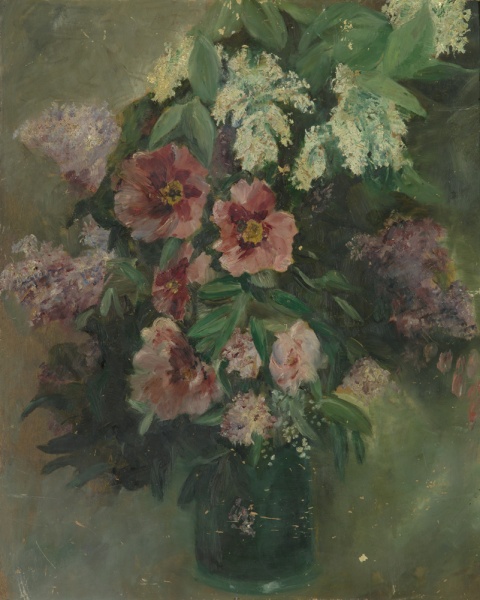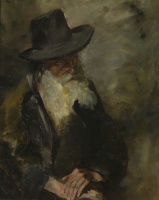

A Jewish Wiseman (recto). Spring Flowers (verso)
| Author: |
Boris Schatz (1866/7–1932)  |
| Created: | late 19th century |
| Material: | hardboard |
| Technique: | oil |
| Dimensions: | 71 × 58 cm |
| Signature: | recto bottom right: B. Shatz |
Both sides of this picture are painted in easy brushstrokes, and both the portrait and the still-life are sketchy, probably done as an exercise. This is one of several paintings by Boris Schatz (1866–1932), who was really a sculptor. The expert in Litvak art Vilma Gradinskaitė attributes the work to the artist’s Parisian period (Litvak Art, 2015, p. 173). Taking each side of the picture as a single work, the combination of spring flowers and an old religious Jew is paradoxical. It is a juxtaposition of maturity and old age. In this case, the symbolism appeared unintentionally, but such a juxtaposition was sought in pictures by Symbolists of old people and spring or summer flowers. A well-known example is the composition Under the arbour (ca 1891) by Arnold Böcklin (1827–1901), now in the Museum of Art in Zürich (Kunsthaus Zürich), in which an old couple are pictured in a garden in early spring, where tulips and hyacinths are just poking out of the ground, and are blooming in carefully arranged flowerpots.
Text author Giedrė Jankevičiūtė
Bezalel. Bezalel is the first artist mentioned in the Old Testament: ‘Then the Lord said to Moses, “See, I have chosen Bezalel son of Uri, the son of Hur, of the tribe of Judah, and I have filled him with the Spirit of God, with wisdom, with understanding, with knowledge and with all kinds of skills – to make artistic designs for work in gold, silver and bronze, to cut and set stones, to work in wood, and to engage in all kinds of crafts”’ (Exodus 31, 1–5). Bezalel designed and decorated the Mishkan, a portable sanctuary in the desert, and several millennia later the first art school in Palestine was named after him. The school was founded in Jerusalem in 1906 by Boris Schatz, a native of Varniai, who dreamt of ‘becoming the high priest of art, worshipping at its altar, showing men its greatness and beauty’ (H. Lewbin, Rebirth of Jewish Art, New York, 1974, p. 14). The Bezalel School of Art built the foundations of professional Israeli art, and Schatz himself is called the father of Israeli art.
Schatz created mainly reliefs and sculptures. Although he did not paint much, he painted ten self portraits the year before his death. A Jewish Wiseman can be attributed to the early Parisian period of his work. This is also evidenced by the still non-standardised transcription of his surname Шац, Shatz. The bouquet of flowers on the reverse side is likely to have been painted at a similar time: both works are characterised by very soft, somewhat unruly brushstrokes, a uniformly greyish-blue background, and the same pink half-tones of the peonies and the man’s hands.
Text author Vilma Gradinskaitė
Source: Law firm Valiunas Ellex art album OBJECTS ON SHOW (2017). Compiler and author Giedrė Jankevičiūtė, STORIES OF LITVAK ART (2023). Compiler and author Vilma GradinskaitėExpositions: "Shalom, Israel! The Paths of Litvak Artists", 16 December 2015 – 13 March 2016, Tolerance Center of the Vilna Gaon State Jewish Museum, Vilnius (curator Vilma Gradinskaite); “Académie de Vilna. Vilnius Drawing School (1866–1915)”, 5 October – 26 November 2017, National Gallery of Art, Vilnius (curator Jolanta Širkaitė); "Litvak Artists in Paris", 25 May 2023 – 29 September, Vytautas Kasiulis Museum of Art, Vilnius (curator Vilma Gradinskaitė). Published: Académie de Vilna: Vilniaus piešimo mokykla 1866-1915 / Vilnius drawing school: Exhibition Catalogue, Nacionalinė dailės galerija 2017 m. 4 d. - lapkričio 26 d., compiled by Jolanta Širkaitė, Vilnius: Lietuvos kultūros tyrimų institutas, 2017, p. 323.








